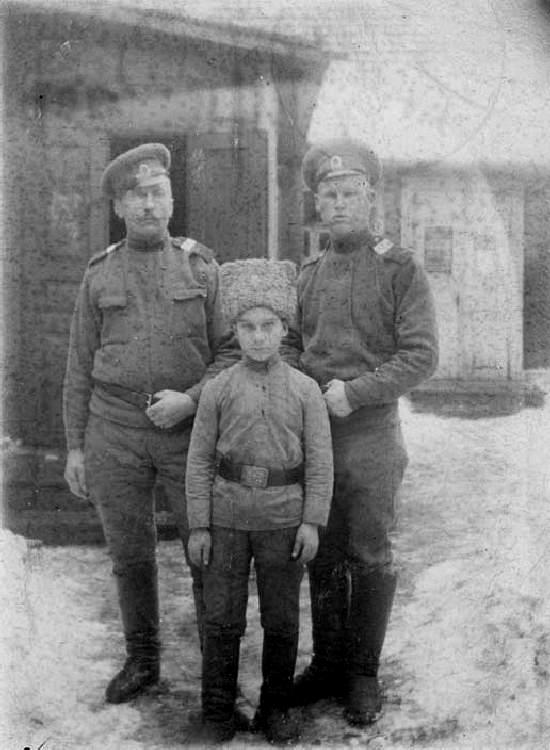
World War I: Latvian Rifles (1915)

Figure 1.-- Here two corporals stand with a boy who is apparently a "Son of Regiment". This apparently meansthat when a soldier is killed, the regiment takes on the care of his son who joins the regiment, esentially adopting orphaned children. The front of the photograph has text in the Latvian language. There is also an enscription on the postcard back which is dated 4/II.1916 (February 4, 1916). We are not sure if this is an Imperial Army unit or the Lativian Rifles. Perhaps a Latvian reader can tell us what the Latvian text says. Put your cursor on the image to see the front text. A Latvian reader has kindly provided a translation. "I am not completely sure about the last line (last 2 words), but it could be something like, "
In the damp forests where slaves choke/
Pain and worry has no end/
Where brother in brothers blood soak/
There will be Fatherland and blood./ Signature - Jekabs" [Miezis]
|
|
While Latvia was a part of the Russian Empire, that does not mean that Latvians were loyal to the Empire. Tsarist authorities were suspicious of both the Baltic Germans and also of the local ethnic populations (Lithuanians, Latvians, and Estonians). Concern over the loyalty of the Baltic population was why Tsarist authorities did not form ethnic non-Russian units in the Baltics. Rather the Baltic people were drafted into overwealmingly Russian Tsarist units. Heavy handed Russian conscription caused resistance to consription even riots in Riga. As the German Army began moving east toward Latvia (April 1915), prominent Latvians, led by Jānis Goldmanis in the Duma call for Tsar Nicholas to approve the creation of ethnic Latvian battalions. They argued that Latvian units would most effectively resist the German advance into Latvia.
We are not sure just what the calculation was of the men who volunteered for the Latvian Rifles. It is likely that most wanted no part of either the Russians or Germans. The Russians had alienated many Latvians, especially the Ruusification effort. The Germans on the other hand were seen as oppresive landowners who dominated Latvian serfs for several centuries. The alternatuive to volunteering for the Latvian rifles in many cases was conscroption into the Russian Army. Seving with other Latvins was probablhy the primary attraction.
Two battalions of Latvian Home Guard were fighting effectively at Jelgava. German advances finally convinced the Russian Stavka (High Commnd) to approve Latvian units (July 1915). The Tsar thus approved the formation of the Latvian Rifles. While loyalty was an issue, it was probably easier to raise these local units as the Germans pressed forward. We are not sure why this was done in Latvia and not elsewhere in the Baltics. At this time the Russians were still in control of Lithuania and the Estonians were considered not loyal enough for separate units. The General Headquarters approved the Latvian request and organized eight regular and one reserve Latvian Riflemen battalions which were named after Latvian towns (July-August 1915). About 8,000 men volunteered. The units had Latvian officers and the use of the Latvian language was tolerated. We also notice terms like the Latish Shooting Battalions (LSB). We think that this was another name for Latvian Rufles, but we are not entirely sure. The Latvian Rifles suffered heavy casualties in the German Christmas offensive (December 1916-January 1917).
Sources
Miezis, Atis. E-mail message (July 18, 2012).
HBC

Navigate the Boys' Historical Clothing Web Site:
[Return to Main Latvian World War I page]
[Aftermath]
[Alliances]
[Animals]
[Armistace]
[Causes]
[Campaigns]
[Casualties]
[Children]
[Countries]
[Declaration of war]
[Deciding factors]
-------[Diplomacy]
[Economics]
-------[Geo-political crisis]
[Home front]
[Intelligence]
[Military forces]
[Neutrality]
[Pacifism]
[People]
[Peace treaties]
[Propaganda]
[POWs]
[Russian Revolution]
[Signals and intelligence]
[Terrorism]
[Trench warfare]
------[Technology]
------[Weaponry]
[Bibliographies]
[Contributions]
[FAQs]
[Images]
[Links]
[Registration]
[Tools]
[Return to Main World War I page]
[Return to Main war essay page]
Created: 4:54 AM 12/22/2009
Last updated: 5:46 PM 7/18/2012



